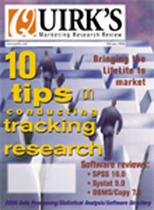Old folks ain't old folks anymore
Editor’s note: Les Harris is managing partner of Mature Marketing and Research, a Boston research firm.
Today’s mature market looks to a new lifestyle of spending more on personal indulgence -- from health and beauty aids to looking young as they age, to food products with extra nutritional value, to fashion apparel, to travel, to having more leisure time, to owning time-shares and condos as second homes, to health maintenance equipment, to owning expensive minivans, to traveling to new destinations.
As the 78 million Baby Boomers turn 50, the perceptions of the 50-plus consumer held by those in marketing and advertising will need to change dramatically. Advertisers will have to look more closely at the social and economic changes that characterize today’s mature market.
Bigger and richer
As of this year, people over 50 will make up one-third of the total adult population. In the next 25 years, the number of those 50 and older is projected to increase to 115 million.
Today’s mature market is the most financially affluent of any age segment. The purchasing power of this group is projected to grow by the year 2005 to more than $1 trillion. Those who are 50 years or older will have the highest household income and the highest per capita annual expenditures.
Because of their desire to take on a new degree of maturity, those over 50 are expected to be major buyers for most consumer products and services: financial, health care, personal care, leisure and travel, apparel, entertainment and automotive.
The generation of the future will move from a youth culture to a mature culture. The Baby Boomers will continue exerting their influence. They will be better educated, more affluent, will be more into personal computers, searching the Internet, investing in mutual funds, and exploring new financial opportunities and second careers.
According to some business reports, Baby Boomers will be the primary segment of the population behind the continued growth in the investment market. Key desires are security, value, reliability and a learning experience.
A new advertising strategy
Advertisers will need to understand the change in sophistication of today’s over 50 population. Boomers want to see people their own age represented in ads for products they buy rather than the 70-plus stereotype or the advertising that uses 20- and 30-year-olds.
Campaigns such as Wendy’s Dave Thomas spots, Levi Strauss clothing ads, Vanity Fair, Saturn, Club Med and Fidelity Investments all are represented by mature spokespeople. Gregory Hines, age 52, advertises Total breakfast cereal, and Discover cards; NYPD Blue star Dennis Franz, age 52, and Bill Parcells, age 57, appear in ads for Cadillac; Candice Bergen, 51, was a long-time Sprint spokeswoman; and the seemingly ageless Tina Turner is a spokeswoman for Hanes Hosiery.
In the research we have conducted, people who are over 50 are increasingly willing to try a new product or a new service if the advertising is presented in an understanding and sensitive manner.
In More, a new magazine aimed at the older woman, advertisers such as American Home Products, Armstrong, Campbell Soup, Coty, General Motors and Revlon all use models who are over 50 to sell their products and services. Mature shows like Touched by An Angel have made CBS the top network with viewers 60 and older.
Travel industry targets the mature market
More of those over 50 are spending a greater amount of time traveling. In response to this increase in demand, the travel industry is seeking to add shorter trips for those who are not yet retired or are semi-retired.
The desire for travel will become more important as the Baby Boomers continue working full- or part-time beyond their retirement age. The American Airlines Active Travel Club for the 62 and older traveler and the United Airlines Silver Wings Plus program are two examples of special programs developed by the travel industry to reach out to the mature traveler.
New opportunities
Boomers want to feel younger, take on new opportunities, be technology-literate. In that vein, some observations:
- The Ford Motor Company is looking to the mature market with the Lincoln sports utility vehicle and pick-up truck. The Buick Motor Division has aimed its Riviera coupe at Baby Boomers.
- Scudder Kemper, manager of the AARP mutual funds, is adding more aggressive funds as its research shows that people over 50 are taking more risks.
- Microsoft and the AARP continue to present seminars on the use of personal computers.
- For AOL subscribers, the AARP offers a quarterly class introducing people to the Internet.
- Del Webb has been wiring its latest retirement communities with Internet access lines.
Different make-up
In essence, those over 50 in the year 2000 and beyond will be of a different psychological and sociological make-up than those over 50 in the 1980s and the early years of the 1990s. As author Gail Sheehy says, “Mature America looks to increased longevity and a new aristocracy of aging. Age 50 is a mid-point, not an end point.”
